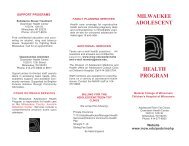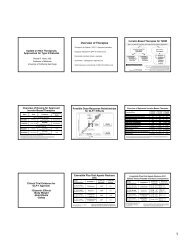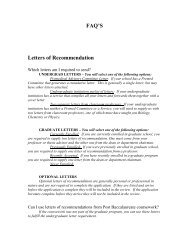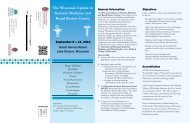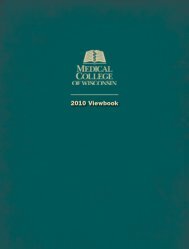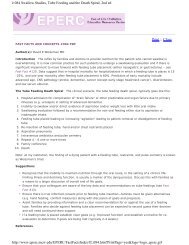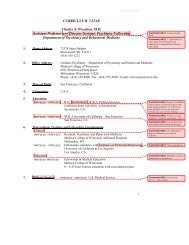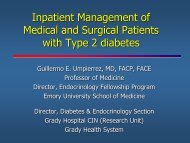fast facts and concepts #072 pdf - Medical College of Wisconsin
fast facts and concepts #072 pdf - Medical College of Wisconsin
fast facts and concepts #072 pdf - Medical College of Wisconsin
Create successful ePaper yourself
Turn your PDF publications into a flip-book with our unique Google optimized e-Paper software.
# 072 Opioid Infusion Titration Orders, 2nd edFAST FACTS AND CONCEPTS <strong>#072</strong> PDFPrint :: CloseAuthor(s): David E Weissman MDIntroduction This Fast Fact will discuss appropriate ways to write opioid infusion titration orders.A bad example: ‘Morphine 2-10mg/hour, titrate to pain relief.’What is wrong with this order?1.2.3.4.This order places full responsibility for dose titration upon the nurse.It provides no guidance regarding how <strong>fast</strong> to titrate (e.g. every hour, every shift?) or dose titrationintervals (e.g. for poorly treated pain, should the dose be raised from 2 to 3 mg, 2 to 10 mg, other?).It poses the potential for overdosage by too zealous dose escalation <strong>and</strong> provides only one option for poorlycontrolled pain – increasing the continuous infusion rate.Given that it takes at least 8 hours to achieve steady-state blood levels after a basal dose change, it makesno pharmacological sense to dose escalate the basal dose more frequently than q 8 hours.A better way to write this order: ‘Morphine 2 mg/hour <strong>and</strong> morphine 2 mg q 15 minutes for breakthroughpain (or 2 mg via PCA dose). RN may dose escalate the PRN dose to a maximum <strong>of</strong> 4 mg within 30 minutes forpoorly controlled pain.’Why is this better?1.2.This order is preferred as it provides a basal rate <strong>and</strong> a breakthrough dose. The breakthrough dose has apeak effect within 5-10 minutes. Thus, if the breakthrough dose is inadequate it can be safely increased, as<strong>of</strong>ten as every 15-30 minutes, to achieve analgesia – without a need for rapid upward titration <strong>of</strong> the basalrate.Reassess the need for a change in the basal rate no more frequently than every 8 hours; use the number <strong>of</strong>administered bolus doses as a rough guide when calculating a new basal rate. However, never increase thebasal rate by more than 100% at any one time. When increasing the basal rate, always administer a loadingdose so as to more rapidly achieve steady-state blood levels.References1.2.3.Principles <strong>of</strong> Analgesic Use in the Treatment <strong>of</strong> Acute <strong>and</strong> Cancer Pain. 5th Ed. Glenview, IL: American PainSociety; 2003. Available at: http://www.ampainsoc.org/pub/principles.htm.Acute Pain Management Guideline Panel. Acute pain management: Operative or <strong>Medical</strong> Procedures <strong>and</strong>Trauma Clinical Practice Guideline. AHCPR Publication No. 92-0032. Available at:http://www.ncbi.nlm.nih.gov/books/bv.fcgi?rid=hstat6.chapter.32241.Management <strong>of</strong> Cancer Pain. Clinical Practice Guideline No. 9; AHCPR Publication No. 94-0592.Rockville,MD. Agency for Health Care Policy <strong>and</strong> Research, US Department <strong>of</strong> Health <strong>and</strong> Human Services, PublicHealth Service; 1992, 1994. Available at: http://www.ncbi.nlm.nih.gov/books/bv.fcgi?rid=hstat6.chapter.18803.Fast Facts <strong>and</strong> Concepts are edited by Drew A Rosielle MD, Palliative Care Center, <strong>Medical</strong> <strong>College</strong> <strong>of</strong><strong>Wisconsin</strong>. For more information write to: drosiell@mcw.edu. More information, as well as the complete set <strong>of</strong>Fast Facts, are available at EPERC: www.eperc.mcw.edu.http://www.eperc.mcw.edu/EPERC/FastFactsIndex/ff_072.htm?PrintPage=yes&logo=logo_eperc.gif
# 072 Opioid Infusion Titration Orders, 2nd edVersion History: This Fast Fact was originally edited by David E Weissman MD. 2nd Edition published July 2006.Current version re-copy-edited April 2009.Copyright/Referencing Information: Users are free to download <strong>and</strong> distribute Fast Facts for educationalpurposes only. Weissman DE. Opioid Infusion Titration Orders. 2nd Edition. Fast Facts <strong>and</strong> Concepts. July 2006;72. Available at: http://www.eperc.mcw.edu/EPERC/FastFactsIndex/ff_072.htm.Disclaimer: Fast Facts <strong>and</strong> Concepts provide educational information. This information is not medical advice.Health care providers should exercise their own independent clinical judgment. Some Fast Facts cite the use <strong>of</strong> aproduct in a dosage, for an indication, or in a manner other than that recommended in the product labeling.Accordingly, the <strong>of</strong>ficial prescribing information should be consulted before any such product is used.ACGME Competencies: <strong>Medical</strong> Knowledge, Patient CareKeyword(s): Pain – Opioids<strong>Medical</strong> <strong>College</strong> <strong>of</strong> <strong>Wisconsin</strong>8701 Watertown Plank Road, Milwaukee, WI 53226www.mcw.edu | 414.955.8296Page Updated 05/17/2013Print :: Closehttp://www.eperc.mcw.edu/EPERC/FastFactsIndex/ff_072.htm?PrintPage=yes&logo=logo_eperc.gif




